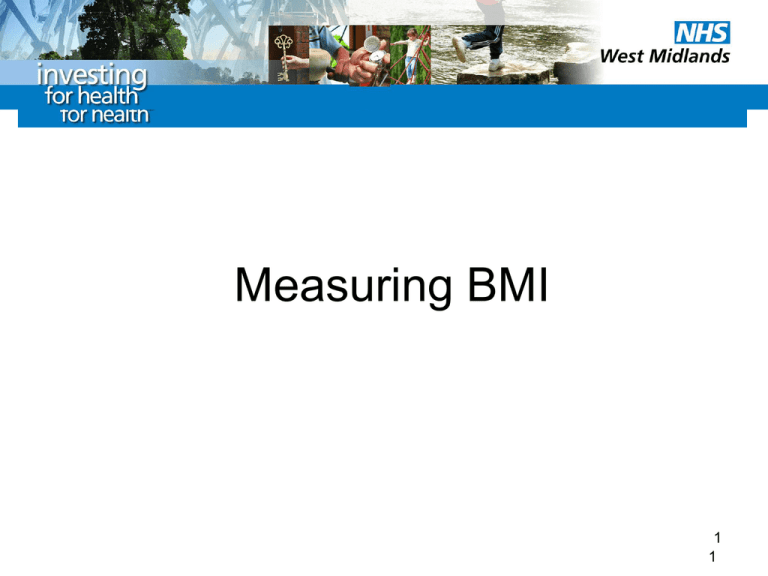Measuring BMI
advertisement

Measuring BMI 1 1 Measuring BMI Body Mass Index or BMI is used as a measure to help define the healthy weight ranges for the adult population. BMI uses weight and height measures to calculate whether someone is a healthy weight for their height. BMI is commonly used because it gives a sound basis for categorising people into healthy weight categories and because it is easily measured without the use of complex equipment. There are limitations to its accuracy – in that it does not take into account muscle/bone structure but it provides a satisfactory measure for most NHS purposes. Other measures of healthy weight including body measurements and body fat measures. 2 Measuring BMI Used alongside a chart like the one on the following slide – or a BMI wheel, BMI measurements enable clients to be categorised by their weight. • BMI less than 18.5 - Underweight • BMI between 18.5 and 24.9 – Normal weight • BMI between 25 and 29.9 – Overweight • BMI above 30 - Obese 3 4 4 How to measure BMI To calculate BMI you need the clients height and weight measurements BMI = Weight in kg (Height in metres x Height in metres) 5 5 Measuring Height Place the stadiometer on a firm, level surface with its stabilisers resting against a vertical surface (wall, door) Ask the client to remove their shoes and any clothing which might interfere with height measurement Ask the client to stand on the height measurer with their feet flat on the floor, heels together and touching the base of the vertical measuring column. The clients arms should be relaxed and their bottom and shoulders should touch the vertical measuring column Position the clients head so that the Frankfurt Plane is horizontal (see next slide). The head piece of the height measure should be lowered gently but firmly onto the head before the measurer positions the clients head in the Frankfurt Plane Measure the clients height in centimetres to the first decimal place (e.g. to the nearest millimetre) E.g. 160.3cm 6 Measuring Height The Frankfurt Plane is an imaginary horizontal that means the ear hole should be lined up with the bottom of the eye socket 7 Measuring Weight Place the scales on a firm, level surface Scales should be properly calibrated (on at least an annual basis) Ask the client to remove their shoes and coat. They should be weighed in normal light indoor clothing Ask the client to stand with both feet in the centre of the scales Measure the clients weight in kilograms to the first decimal place (e.g. to the nearest 100 grams) e.g. 80.2kg 8 Rules for rounding numbers Sometimes the results of a calculation gives a number with lots of decimal places For this project we will round BMI to 1 decimal place Rule for rounding: if the next number to the right of the decimal place you require is 5 or more, you round the figure up to the next highest number, and if it's 4 or less it remains the same. For example, to correct 1.666 to 1 dp, find the first decimal place and then look at the next decimal place to its right, 1.666. As this number is greater than 5 we have to round up, and the amount becomes 1.7 corrected to one decimal place (1 dp). If the original number had been 1.646 then the value corrected to one decimal place would be 1.6 (1 dp) 9 Calculate BMI - Example Sandra is 160.2cm tall and weighs 88.6kg. Convert height to metres 160.2cm = 1.602m 1.602 x 1.602 = 2.566404 BMI = 88.6 = 34.5 (to 1 dp) 2.566404 10











